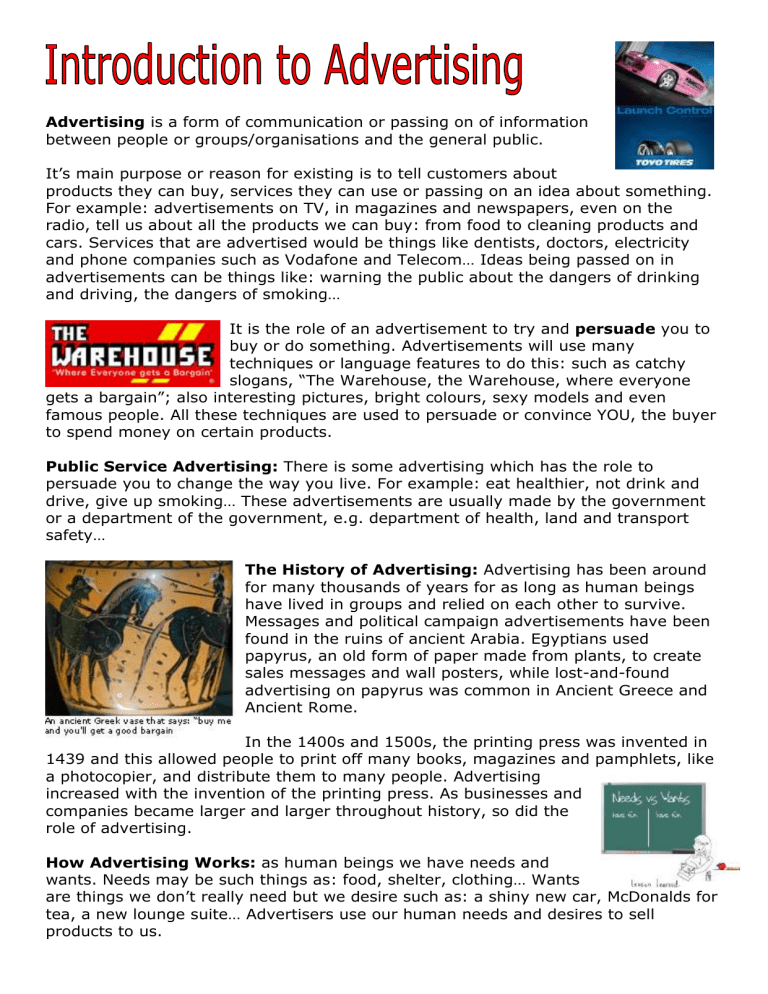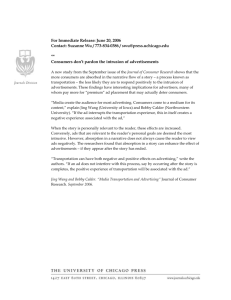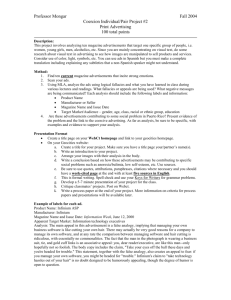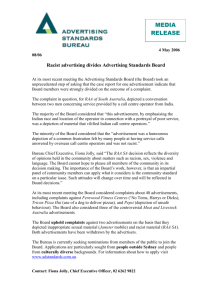Introduction to Advertising: Types & Techniques

Advertising is a form of communication or passing on of information between people or groups/organisations and the general public.
It’s main purpose or reason for existing is to tell customers about products they can buy, services they can use or passing on an idea about something.
For example: advertisements on TV, in magazines and newspapers, even on the radio, tell us about all the products we can buy: from food to cleaning products and cars. Services that are advertised would be things like dentists, doctors, electricity and phone companies such as Vodafone and Telecom… Ideas being passed on in advertisements can be things like: warning the public about the dangers of drinking and driving, the dangers of smoking…
It is the role of an advertisement to try and persuade you to buy or do something. Advertisements will use many techniques or language features to do this: such as catchy slogans, “The Warehouse, the Warehouse, where everyone gets a bargain”; also interesting pictures, bright colours, sexy models and even famous people. All these techniques are used to persuade or convince YOU, the buyer to spend money on certain products.
Public Service Advertising: There is some advertising which has the role to persuade you to change the way you live. For example: eat healthier, not drink and drive, give up smoking… These advertisements are usually made by the government or a department of the government, e.g. department of health, land and transport safety…
The History of Advertising: Advertising has been around for many thousands of years for as long as human beings have lived in groups and relied on each other to survive.
Messages and political campaign advertisements have been found in the ruins of ancient Arabia. Egyptians used papyrus, an old form of paper made from plants, to create sales messages and wall posters, while lost-and-found advertising on papyrus was common in Ancient Greece and
Ancient Rome.
In the 1400s and 1500s, the printing press was invented in
1439 and this allowed people to print off many books, magazines and pamphlets, like a photocopier, and distribute them to many people. Advertising increased with the invention of the printing press. As businesses and companies became larger and larger throughout history, so did the role of advertising.
How Advertising Works: as human beings we have needs and wants. Needs may be such things as: food, shelter, clothing… Wants are things we don’t really need but we desire such as: a shiny new car, McDonalds for tea, a new lounge suite… Advertisers use our human needs and desires to sell products to us.
Appeals: As humans we have many needs as wants as mentioned above and advertisers attempt to appeal to these needs and wants. Below are some ways that advertisers attempt to appeal to us:
Appeals to authority: this is when advertisements use famous people such as TV stars, athletes, politicians… who support a product or idea; they tell us how good the product or idea is and because we admire them, we believe them and are more likely to buy the product or take the idea on board.
Appeals to snobbery: Sometimes advertisers can convince us that by buying a product in an advertisement we can become part of the elite. For example, if we buy the latest Toyota car all our neighbours will see how successful we are…
Appeals to science: this is when an advertisement gives us some scientific proof that a product will work. E.g. “scientists have tested and found that Nivea
Visage moisturiser will reduce wrinkles by 75%.”
Appeals to saving money: everyone loves a bargain and the idea of saving money. Many advertisements will tell us that the product they are advertising is the cheapest around. Prices of products are also often advertised at, for example, $19.95 or $199.95 rather that
$20.00 or $200.00 because it sounds cheaper.
Appeals to being the same as
everyone else: many people do not want to stand out from the crowd as being different and advertising often appeals to this. They appeal to the fact that we want to look like everyone else, to be “in.” An example would be advertising clothes that are the latest fashion, that everyone is wearing at the moment,
Appeal for affection: Many advertisements appeal to our human need to have a relationship with another human being. For example, lynx body spray advertisements appeal to men’s desire to attract beautiful women.






